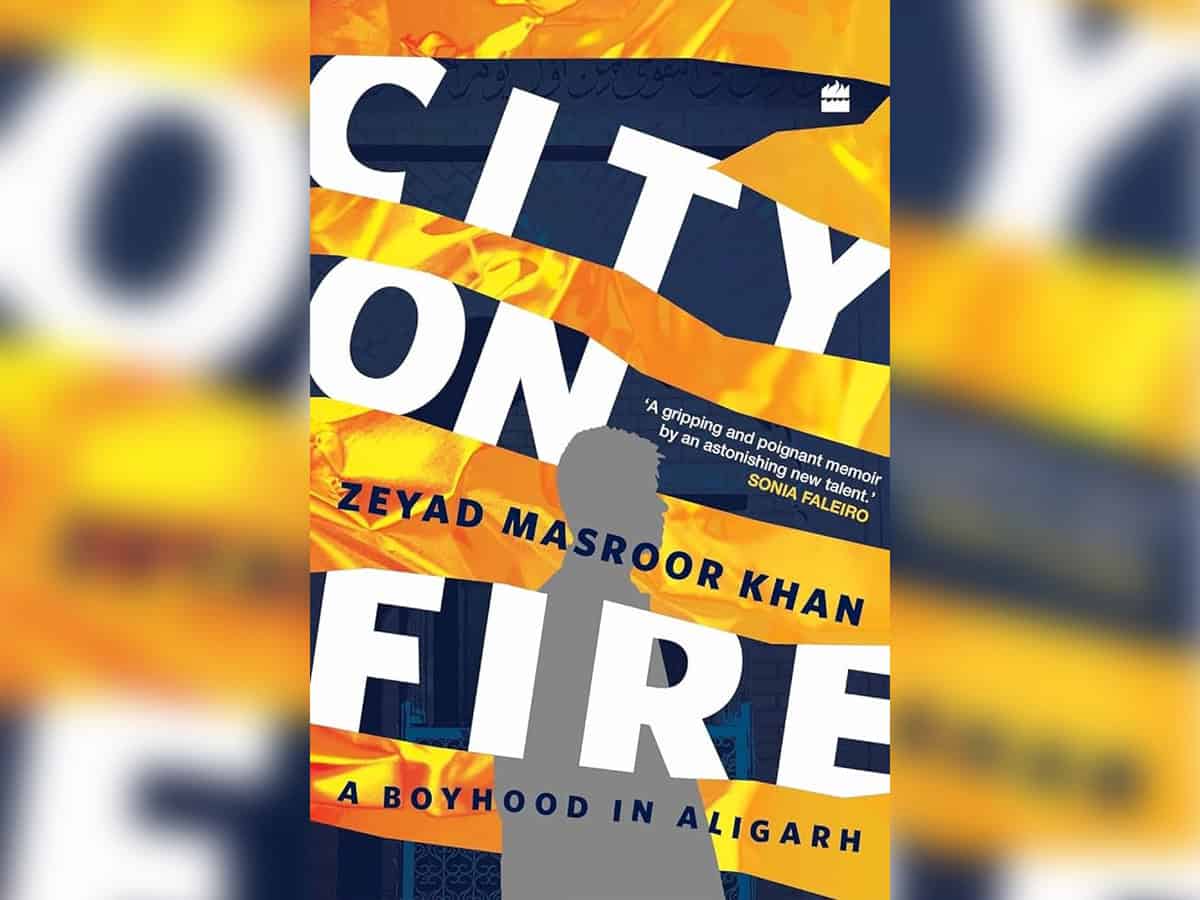
City on Fire by Zeyad Mansoor Khan, is a memoir in which he describes the hateful environment Muslims have had to endure in post-Babri Mosque demolition (6 December 1992) India. Although mainly based in Aligarh, and a bit in Delhi, this frank, outspoken, and gripping memoir should serve as an alert on what disillusionment, hopelessness, and continuous persecution of about two hundred million Muslims, especially the youth, can lead to.
Faced with Islamophobic taunts in the suffocating environment of Aligarh, Zeyad was attracted to Tablighi Jamaat, which gave him ‘a sense of camaraderie, community, and purpose’.
Outside the mosque, the environment was too Islamophobic where Hindus and Muslims disliked and distrusted each other with a passion that reminded one of blazing forest fires. “You, the descendant of Shah Jamal, why don’t you offer namaz [prayer] in Pakistan?” they called out from their shops as we went to Friday prayers. Even politicians in Aligarh have publicly asked Muslims to ‘go to Pakistan.’” He describes life in Aligarh and says, ‘Riots were an inseparable part of our lives.’
In school, students got along well with each other, yet they did not hesitate to exchange ‘religiously charged jokes at each other and threaten to raid each other’s homes during the next riots.’
In such an atmosphere, by devoting more and more time to Tablighi Jamaat, says Zeyad, “I was the one escaping from the world, seeking sanctuary inside the mosque, a boy for whom nothing mattered except his religious identity. Anyone, including my own father, who disagreed, was a sinner and an obstacle to a larger goal. He is a selfish person who cares only for himself and not for the community. These are the Muslims who make us weak, I thought.”
Despite his father’s disapproval, young Zeyad continued attending Tablighi Jamaat and started giving sermons. “The first time I stood up on the podium at the mosque, it gave me a feeling of power like never before. I could see people listening to me with respect in their eyes. In school, I was seen as a ruffian who was alienated for who he was, but here at the mosque, I was seen as a role model to be emulated.”
Bear in mind that Tablighi Jamaat is an organisation in which there is no official membership. Any Muslim can join it without applying to anyone, and he or she can leave it anytime without notice. It is a peaceful organisation with focus on making Muslims spiritually strong by making them punctual in prayer and fasting. They only focus on improving the outcome of one’s deeds in the hereafter. Or, as the Tablighis themselves describe the organisation, they only talk about matters above the skies or under the earth, i.e., rewards or punishment in the grave and on the Day of Judgment.
Yet a young man was unable to hold back the anger building up in him. Zeyad was turning into a rebel, and to show his Muslimness, instead of saying good morning, he greeted the Christian headteacher of his Christian school by saying Assalamu Alaykum. The teacher, Father Dennis D’Souza, disciplined Zeyad by ‘holding my long brown hair with his other hand; he dragged me out of the queue. If I hadn’t been so terrified, I would have complimented him on his phenomenal strength. For the next five minutes, he kept slapping me as hard as he could until my face was red with the imprint of his fingers.’ But instead of disciplining and reforming the young lad it toughened Zeyad even more, to the extent that he defended Osama bin Laden in a class discussion. However, he was baited into doing so by his teacher.
While reading the book, from a bit of depression to smiles, one goes through various feelings, but any conscientious person would be particularly perturbed by the thought of what would have happened to this young man—and what may happen to several disgruntled young men who are having to endure similar tests every day in India—if he had come into contact with a sinister group. Fortunately, India is still free from the curse of such groups.
After his schooling, Zeyad joins Aligarh Muslim University (AMU). But interestingly, in contrast to the image created by India’s ‘godi media’ of this great institution, instead of becoming a hardcore fundamentalist or a radical, he becomes a liberal. After his BA, he goes to another Muslim institution, Jamia Millia Islamia (JMI), Delhi, with a similar historical background and similar image, and here his liberal thinking becomes even stronger.
After completing his master’s in mass communication, Zeyad joins Reuters and later goes to live in a Hindu-dominated area where he and his other Muslim friends find it difficult to find accommodation.
They are accepted by a landlord because of the ‘Hinduness’ of their co-tenant. If some Muslims ever told Zeyad of the possible dangers of living in a Hindu area, he would reply: ‘Delhi is beyond riots and communal tensions.’
But one day, as he leaves home for work, a neighbour greets him and asks his name. The moment the seemingly friendly neighbour finds out that Zeyad is a Muslim, ‘his smile disappeared, replaced by a frown, disgust reigning on his face.’ He asks, ‘Khan? Are you a Mohammedan?’ He goes on: ‘You have now lost all my respect. Everything else about you is fine except your name… You people create trouble wherever you go… We don’t want Muslims living here.’
This was not a one-off incident. He had more shocks in the offing. One day when he was at work, the son of his father’s eldest brother, who had migrated to Pakistan years ago, found him on Facebook and called him on the Messenger app. So, he went out to talk to him about their extended family. When he went back to his desk, his colleagues asked which girl he had been talking to. Upon being told that he was talking to his cousin in Pakistan, ‘The expression on their faces changed dramatically. “Pakistan?” they said cautiously. It was as if I had committed a crime.’ This experience of Zeyad reminds one of the experiences of celebrated Urdu writer Qurratulain Hyder at the Illustrated Weekly of India during the Indo-Pak war in 1971.
The attitude of Indian journalists towards the Shaheen Bagh protest (December 15, 2019– March 24, 2020) and its coverage made him disillusioned with journalism, prompting him to quit his job and return to Aligarh to write this book. ‘Most Hindus, even the progressive ones, had a binary perception of Muslims.’ He writes, ‘One is a fundamentalist, patriarchal figure, donning a skullcap, eager to blow themselves up for Islam; the other is an exotic, modern individual, relishing biryanis and indulging in Urdu poetry. In Aligarh, I was the former while, in Delhi, I personified the latter. Subconsciously, I had also begun presenting myself as the latter, striving to earn acceptance from my liberal friends.’
Zeyad devotes a chapter to his time spent at AMU and also summarizes the history of this institution. However, he writes “He would have better served his alma mater and many of his readers by providing more information about the participation of AMU alumni in the freedom struggle. Its alumni include two vice presidents of India, cabinet ministers, ten state chief ministers, dozens of top Muslim politicians, Supreme Court judges, journalists, writers, poets, actors, and historians.
It is the only Indian university whose alumni became heads of state in four countries: India, Pakistan, Bangladesh, and the Maldives,” he writes.
The writer briefly addresses corruption among some of the teachers at AMU and the exploitation of students by them, something shocking and unthinkable for many of its old students. With time, everything changes, and AMU can’t be an exception.
Zeyad provides a detailed account of Aligarh’s demography, the history of its various streets and lanes, and talks about its famous historic Jama Masjid. He would have done his readers a favour by mentioning that the Imam of Jama Masjid, Maulana Abdul Jalil, led a battalion of revolutionaries in the 1857 anti-British uprising and was martyred along with 75 of his soldiers, all of whom are buried inside the Jama Masjid.
Zeyad was in school when he decided, ‘I wanted to be a journalist—somebody who would change people’s perceptions of Muslims and write about people that nobody wrote about.’ There is no doubt that he has done it wonderfully well. With the courage displayed recently in their books by Muslims like Zeyad Masroor Khan, Ziya Us Salam, Ghazala Wahab, and Hilal Ahmad, the perception of Muslims will also change. Anyone who wants to know what is happening to Muslims in India must read this book.
City on Fire: A Boyhood in Aligarh
Author: Zeyad Mansoor Khan
Publisher: Harper Collins, India,
Pages 297. Hardback
Price: £19.99




